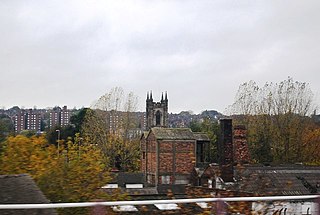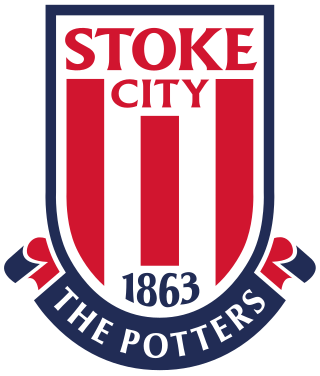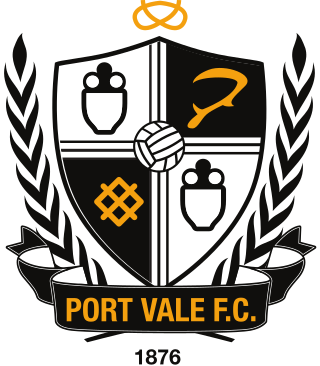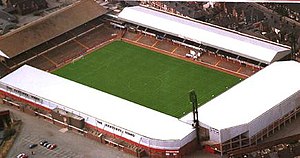
Staffordshire is a landlocked ceremonial county in the West Midlands of England. It borders Cheshire to the north-west, Derbyshire and Leicestershire to the east, Warwickshire to the south-east, the West Midlands county and Worcestershire to the south, and Shropshire to the west. The largest settlement is the city of Stoke-on-Trent, and the county town is Stafford.

Sir Stanley Matthews was an English footballer who played as an outside right. Often regarded as one of the greatest players of the British game and one of the greatest players of all time, he is the only player to have been knighted while still playing football, as well as being the first winner of both the European Footballer of the Year and the Football Writers' Association Footballer of the Year awards. His nicknames included "The Wizard of Dribble" and "The Magician".

Stoke-on-Trent is a city and unitary authority area in Staffordshire, England, with an area of 36 square miles (93 km2). In 2022, the city had an estimated population of 259,965. It is the largest settlement in Staffordshire and is surrounded by the towns of Newcastle-under-Lyme, Alsager, Kidsgrove and Biddulph, which form a conurbation around the city.

Stoke City Football Club is a professional association football club based in Stoke-on-Trent, Staffordshire, England. The team competes in the EFL Championship, the second level of the English football league system.

Port Vale Football Club are a professional football club based in Burslem, Stoke-on-Trent, England, which compete in EFL League Two, the fourth tier of the English football league system. Vale are named after the valley of ports on the Trent and Mersey Canal. They have never played top-flight football, and hold the record for the most seasons in the English Football League (113) without reaching the first tier. After playing at the Athletic Ground in Cobridge and The Old Recreation Ground in Hanley, the club returned to Burslem when Vale Park was opened in 1950. Outside the ground is a statue of Roy Sproson, who played 842 competitive games for the club. The club's traditional rivals are Stoke City, and games between the two are known as the Potteries derby.

The Bet365 Stadium is an all-seater football stadium in Stoke-on-Trent, Staffordshire, England and the home of EFL Championship club Stoke City. The stadium was previously called the Britannia Stadium but was renamed on 1 June 2016 when the club entered into a new stadium-naming-rights agreement with its parent company, Bet365. It has a capacity of 30,089 following the completion of expansion works in 2017.

Vale Park is a football stadium in the area of Burslem, Stoke-on-Trent, Staffordshire, England, and it has been the home ground of Port Vale Football Club since its opening in 1950. It has a current capacity of 15,695, and was renovated during 1989–1998 to become an all-seater stadium.
Anthony Waddington was an English football player and manager. He managed both Crewe Alexandra and Stoke City.

The Staffordshire Senior Challenge Cup is a football cup tournament based in the county of Staffordshire in England first competed for in 1877–78 (then under Sheffield Rules. Organised by the Staffordshire Football Association, it is competed for by a mix of clubs from Staffordshire and the surrounding areas. Both professional and amateur clubs may enter. In the modern age, however, professional teams such as Stoke City and Port Vale, the main clubs in Staffordshire, usually field a reserve team as they place more prestige on their professional league and cup competitions. This has left the door open for non-league sides to have more success in the cup as it is classed as a bigger achievement for them to win it.

John Knight Mudie was a Scottish international footballer who played as a forward. He won seventeen caps for his country, helping the Scotland national team to qualify for the 1958 FIFA World Cup.

Stoke City Football Club has its origins in Stoke Ramblers, a team formed by former pupils of the Charterhouse School whilst they were apprentices at the North Staffordshire Railway. The club dropped the Ramblers from their name, becoming Stoke Football Club and in 1888 they were founding members of the Football League. In 1925, the club's name was changed for the final time to Stoke City Football Club when Stoke-on-Trent was granted city status.

In English football, the Potteries derby is the local derby between the two major clubs in the city of Stoke-on-Trent – Port Vale and Stoke City, first contested in 1882. Port Vale plays at Vale Park whilst Stoke play at the bet365 Stadium, the two grounds are separated by roughly 4.3 miles (6.9 km). The fans of each club both consider the other to be their main rivals; this has led to a heated atmosphere at these matches. One study in 2019 ranked it as the joint-28th biggest rivalry in English professional football, level with the Manchester derby. The two teams have met in 92 competitive first-team fixtures, including 44 English Football League, six FA Cup and two Football League Trophy fixtures, with the remaining 40 meetings coming in regional cup competitions.
The 1885–86 season was the eighth season in the history of West Bromwich Albion Football Club. In what was their inaugural season as a professional club, Albion moved to the Stoney Lane ground after leaving their previous home at Four Acres. The team also changed the colour of its kit, wearing blue and white striped jerseys for the first time. As league football had not been introduced in England at the time, the team competed solely in cup competitions and friendly matches throughout the season, playing 52 matches in total.
The 1975–76 season was Stoke City's 69th season in the Football League and the 45th in the First Division.
The 1996–97 season was Stoke City's 90th season in the Football League and 34th in the second tier. It was also Stoke's final season at their Victoria Ground.
The 1886–87 season was the ninth season in the history of West Bromwich Albion Football Club. The club reached the FA Cup final for the second successive season, but again finished as runners-up, losing 0–2 to local rivals Aston Villa. Albion also reached the final of two regional cup competitions, winning the Staffordshire Senior Cup and finishing as runners-up in the Birmingham Senior Cup. In addition, they took part in the Walsall Senior Cup and Birmingham Charity Cup, as well as playing a number of friendly matches.
The 1883–84 season was the first season Stoke took part in a major competitive competition, the FA Cup.
The 2014–15 season is Stoke City's seventh season in the Premier League and the 59th in the top tier of English football.
Stoke City Football Club is an English football club based in Stoke-on-Trent, Staffordshire. The club was founded in 1863 and has competed in the English football league system since 1888. They played in the UEFA Cup in 1972–73 and 1974–75, before qualifying for the tournament in 2011–12 under the new name of UEFA Europa League. The club also entered the Anglo-Italian Cup and the Texaco Cup.













